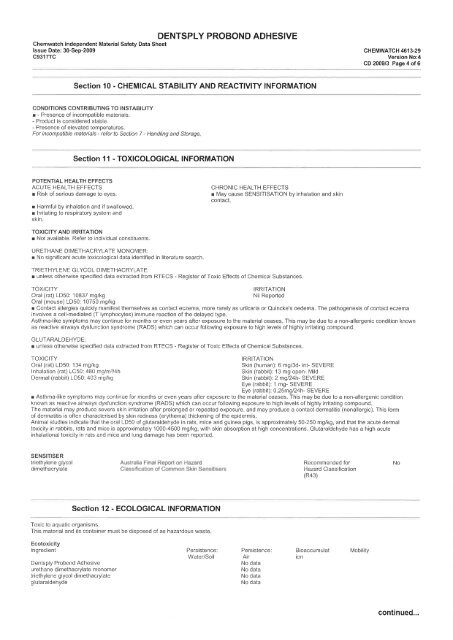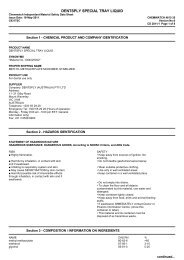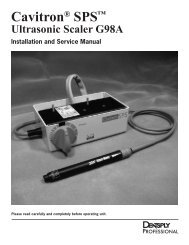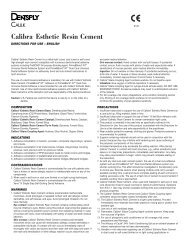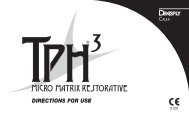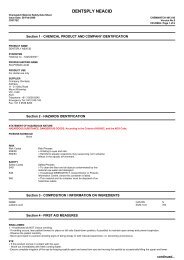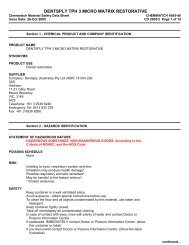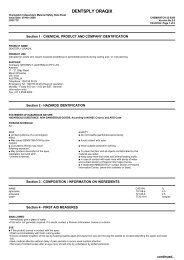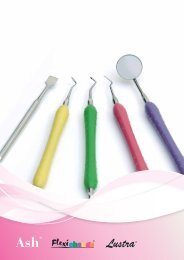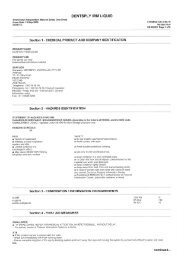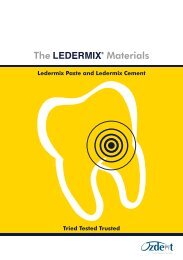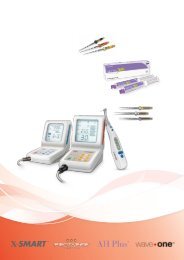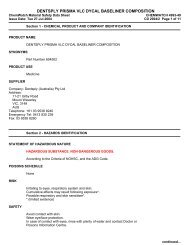105883-40-7
105883-40-7
105883-40-7
Create successful ePaper yourself
Turn your PDF publications into a flip-book with our unique Google optimized e-Paper software.
DENTSPLY PROBOND ADHESIVE<br />
Chemwatch lndependent Material Safety Data Sheet<br />
lssue Date: 30-Sep-2009 CHEMWATCH 4613-29<br />
C9317TC<br />
Version No:4<br />
CD 2009/3 Page 4 of6<br />
Section 10 - CHEMICAL STABILITY AND REACTIVITY INFORMATION<br />
CONDITIONS CONTRIBUTING TO INSTABILITY<br />
r - Presence of incompatible materials<br />
- Product is considered stable.<br />
- Presence of elevated temperatures.<br />
For incompatible mater¡als - refer to Sect¡on 7 - Handling and Storage<br />
Section l1 - TOXICOLOGICAL INFORMATION<br />
POTENTIAL HEALTH EFFECTS<br />
ACUTE HEALTH EFFECTS<br />
r Risk of serious damage to eyes<br />
r Harmful by inhalation and if swallowed<br />
r lrritating to respiratory system and<br />
skin<br />
CHRONIC HEALTH EFFECTS<br />
r May cause SENSITISATION by inhalation and skin<br />
contact<br />
TOXICITY AND IRRITATION<br />
r Not available. Refer to individual constituents.<br />
URETHANE DII\4ETHACRYLATE MONOMER:<br />
r No significant acute toxicological data identified in literature search.<br />
TRIETHYLENE GLYCOL DIMETHACRYLATE:<br />
r unless otherwise specified data extracted from RTECS - Register of Toxic Effects of Chemical Substances.<br />
TOXICITY<br />
IRRITATION<br />
Oral (rat) LD50: 10837 mg/kg<br />
Nil Reported<br />
Oral (mouse) LD50: 10750 mg/kg<br />
r Contact allergies quickly manifest themselves as contact eczema, more rarely as urt¡caria or Quincke's oedema. The pathogenesis of contact eczema<br />
involves a cell-mediated (T lymphocytes) immune reaction of the delayed type.<br />
Asthma-like symptoms may continue for months or even years after exposure to the material ceases This may be due to a non-allergenic condit¡on known<br />
as reactive airways dysfunction syndrome (RADS) which can occurfoliowing exposure to high levels of highly irritating compound.<br />
GLUTARALDEHYDE:<br />
r unless otherwise specifìed data extracted from RTECS - Registerof Toxic Effects of Chemical Substances.<br />
TOXICITY<br />
Oral (rat) LD50: '134 mg/kg<br />
lnhalation (rat) LC50: 480 mg/m'/4h<br />
Dermal (rabbit) LD50: <strong>40</strong>3 mg/kg<br />
IRRITATION<br />
Skin (human): 6 mg/3d- int- SEVERE<br />
Skin (rabbit): 13 mg open- N4ild<br />
Skin (rabbit): 2 mgl24h- SEVERE<br />
Eye (rabbit): 1 mg- SEVERE<br />
Eye (rabbit): O 25mgl24h- SEVERE<br />
r Asthma-like symptoms may continue for months or even years after exposure to the material ceases This may be due to a non-allergenic condition<br />
known as reactive airways dysfunction syndrome (RADS) which can occur following exposure to high levels of highly irritating compound<br />
The material may produce severe skin irritation after prolonged or repeated exposure, and may produce a contact dermatitis (nonallergic) Th¡s form<br />
of dermatitis is often characterised by skin redness (erythema) thickening of the epidermis<br />
Animal studies indicate that the oral LD50 of glutaraldehyde in rats, mice and guinea pigs, is approximately 50-250 mg/kg, and that the acute dermal<br />
toxicity in rabbits, rats and mice is approximately 1000-4500 mg/kg, with skin absorption at high concentrat¡ons Glutaraldehyde has a high acute<br />
inhalational toxicity in rats and mice and lung damage has been reported<br />
SENSITISER<br />
triethylene glycol<br />
dimethacrylate<br />
Australia Final Report on Hazard<br />
Classification of Common Skin Sensitisers<br />
Recommended for<br />
Hazard Classification<br />
(R43)<br />
No<br />
Section l2 - ECOLOGICAL INFORMATION<br />
Toxic to aquatic organisms<br />
This material and its container must be disposed of as hazardous waste<br />
Ecotoxicity<br />
lngredient<br />
Dentsply Probond Adhesive<br />
urethane dimethacrylate monomer<br />
triethylene glycol dimethacrylate<br />
glutaraldehyde<br />
Persistence: Persistence: Bioaccumulat Mobility<br />
Water/Soil Air ion<br />
No data<br />
No data<br />
No data<br />
No data<br />
continued...


